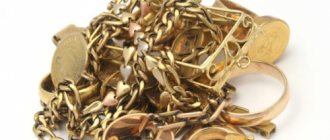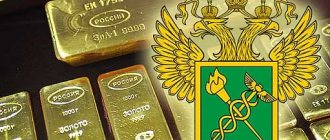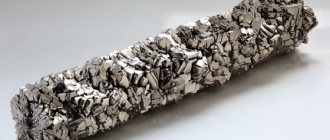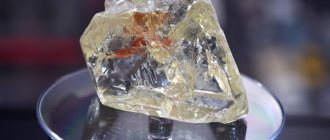In the case when there is a sale of precious minerals within the country or abroad, which is not controlled, this undermines the stability of the market, leads to the fact that the metals depreciate, and currency rates fluctuate. To prevent such a situation from happening, the extraction and sale of natural materials is the responsibility of state authorities. To conduct such activities you will need to obtain a special permit or license. An article of the Criminal Code of the Russian Federation is provided for illegal trafficking of precious metals.
Exceptions
Some states of precious metals will not be considered as the subject of Article 191 of the Criminal Code of the Russian Federation. These include:
- Jewelry. They are understood as objects and various kinds of decorations that are made using artistic processing in its various manifestations. Precious metals are processed in combination with semi-precious, precious or counterfeit stones and other natural materials. Or they can be made entirely of precious metal;
- Household products made from precious metals. This means that such an item does not belong to the type of personal jewelry; items used in everyday life are used. This could be dishes, weapons, religious objects, etc.;
- Objects of art, antiquities or antiques, in the manufacture of which precious metals or stones were used;
- Scrap jewelry and other household items. These may be unusable, broken jewelry and items that can be recycled into other products;
- Gold leaf. These are thin films of gold that are used for decorative purposes;
- Discs for dental prostheses;
- State awards made using precious stones and metals;
- Collectible coins.
Important! In all of these cases, it is not taken into account how objects and decorations are made; it may also be a handicraft method. In addition, it does not matter whether the stamp is affixed or not. Clauses 3, 5, 7, 8 are an exception only for one-time transactions.
Specific qualifications
The specificity of the qualification of this type of act is whether this or that operation is permissible.
It is determined by the state in which precious metals and stones are located. As an example, we can consider the situation with a cut diamond that has a commercial form. It can be transferred, transported and perform other various operations only if there is a document that confirms the purchase of the stone. With the help of a document, you can prove that the stone was not misappropriated.
If we talk about the native brother of this stone, which does not have polished edges, then the performance of any actions with it by a subject who does not have a license is considered a crime.
A similar situation occurs when performing operations with stones that are not processed. Even industries that have official permission to operate with these stones and metals cannot implement it if the metals are required to replenish the budget’s gold reserves.
If even a small amount of gold dust or nuggets is in the possession of a private person, then this is fraught with criminal liability for him. This is due to the fact that an individual cannot act as a subject who is allowed to circulate stones and metals classified as precious.
Don't deprive yourself of prey
One of these pioneers was mining engineer Nikolai Anosov, who carried out surveys in 1858 along one of the right tributaries of the Verkhnyaya Zeya. Near Mount Chichegur he came across an unnamed key, which he called the “Golden Treasure”. There Anosov discovered the richest deposits of gold, rumors about which regularly penetrated into European Russia. From then until 1920, according to conservative estimates, about a thousand tons of gold were mined in Far Siberia. Of course, mining was carried out both by legal methods (buying out territories, paying taxes, hiring miners), and by groups of insurgents who took gold using barbaric methods. This led to the flourishing of banditry and, as a consequence, to the creation of short-term “golden” republics, which collapsed with the development of veins and placers. There was a real war for gold: having learned about such a republic of “free miners,” the legal owners of the land carried out mass executions or set gangs of bandits against illegal mines. To this day, illegal miners in the taiga are called “predators.” They are called this because they are engaged in theft of gold from the depths, without buying the land for rent, without paying any taxes to the treasury. And also because the pit mining method they used, in which abandoned gold remains in the pillars between the pits, made the placers unsuitable for further development. Nevertheless, the “predators” always kept their noses to the wind and were the first to reach the gold veins. They are famous for being the discoverers of the Zolotaya Gora deposits, the gold placers of the Savushkin and Millionny streams, the upper reaches of the Ulunga, the Gilyuy River, and the Oktyabrsky mine. Unya-Bomsky and Sugdzhar-Toksky mine areas, the no less famous and mysterious Pyrite Cliff.
Storage and theft
According to Instruction No. 68, precious stones and metals are stored in premises that meet the requirements prescribed by law regarding technical strength and equipment with fire and security alarms.
Important! The premises and cabinets where these items are stored must be sealed, sealed, locked and handed over to security. Only responsible persons or a commission will be able to open them, with permission obtained from management. Taking into account the specificity of the criminal act under consideration, it is necessary to consider the type of theft that is associated with the performance of professional duties. These include fraud, theft, embezzlement or misappropriation.
Initially, signs are identified that are inherent in all types of theft, including the fact that the object is property.
The property has the following characteristics:
- has a certain value, that is, if things are seized that have no material value, no crime is formed;
- the property must belong to another person, this means that the culprit is a financially responsible person;
- the cost exceeds one established minimum wage.
The objective side is expressed in the confiscation and (or) circulation of someone else’s property by the perpetrator for his own benefit. When the culprit seized an item, but did not get the opportunity to dispose of it, it is considered as theft. The act is completed from the moment of seizure and the opportunity to dispose of the property at one’s own discretion. If we consider the theft of precious metals from production, then it is considered completed from the moment the metal left the production area and was taken out through the entrance.
If an employee is detained at a checkpoint, then the offense is assessed as attempted theft. If the stolen metal was kept by the culprit for a short time, then this provides grounds for classification under Article 191 of the Criminal Code of the Russian Federation under a set of crimes.
The subjective side is represented by direct intent.
Punishment
The punishment depends on the severity of the crime.
The article of the Criminal Code, which establishes liability for illegal transactions with precious metals, provides for the following types of punishment:
- Mandatory work;
- Prison term;
- Fine.
Compulsory work is assigned for a period of up to 5 years, there is no lower limit. The duration depends on the damage caused to the state's economy. Assigned to both individuals and members of an organized group.
The prison term lasts up to 5 years for single criminals and up to 7 years for group members. It also depends on the severity of the crime. There is no lower limit. Appointed as an alternative to compulsory work.
The fine is the income of the convicted person for 3 years (maximum - 500,000 rubles), if he committed the crime alone, or income for 5 years (maximum - 1 million rubles) for group members. No lower limit has been established. It may be in addition to a prison sentence or compulsory labor, an alternative to other types of punishment, or not assigned at all.
The article indicates that a transaction worth more than 1.5 million rubles is considered to be a particularly large transaction. The penalty indicated as the maximum is awarded in such cases. If the damage to the state was not so catastrophic, the judge has the right to impose a more lenient punishment. Including a suspended sentence.
Qualifying features
Large size provided for in Part 1 of Article 191 of the Criminal Code of the Russian Federation is considered as qualifying signs of this act. Its amount is determined in the note to Article 170.2 of the Criminal Code and is equal to 2 million 250 thousand rubles.
Part two includes such qualifying criteria as the commission of an act by a group of persons by prior conspiracy or by an organized group.
Organized group:
- is sustainable;
- its members have united to commit one or more criminal acts;
- Each participant has their own role and responsibilities.
A group of persons by prior conspiracy:
- several persons (at least two) agreed to commit a crime;
- in this case, an agreement could be reached before the crime began.
Features of the investigation
The priority direction of the process of investigating a criminal act regarding precious metals and stones is their presence, which provides the basis for qualifying the act under the article in question.
If a situation arises where there are no materials that are the subject of Article 191 of the Criminal Code of the Russian Federation, further investigation becomes impossible.
After the jewelry is seized, an analysis is carried out aimed at establishing the possibility of classifying the materials as prohibited for circulation. If, after assessing the materials, it is determined that an appropriate permit is required to conduct transactions with metals and stones, then the owner is required to provide documentation confirming the legality of the transaction.
The last stage is the analysis of the transaction regarding its legality. If it is completed successfully, then criminal liability does not apply. If the legal requirements for the handling of stones and metals are not met, liability arises.
A comment
Currently, Article 191 of the Criminal Code of the Russian Federation includes 2 parts.
The totality of economic relations is provided as the generic object of this criminal act. A species object is a relationship that develops in the sphere of economic activity. Direct - relations in the sphere of legal circulation of precious metals and stones, pearls. For information! Article 191 of the Criminal Code of the Russian Federation is of a referential nature: this means that when passing a sentence, the court must indicate which rules were violated by the perpetrator. First of all, this is an act adopted at the legislative level in 1998 called “On Precious Metals and Precious Stones.” The subject matter of the act includes precious metals, stones or pearls. It should be borne in mind that precious stones include items that contain the specified content, as well as raw materials that include a small content of precious metals. In the case where the culprit acted intentionally, then when there is an attack on raw materials, including precious metals, the assessment is given under Article 191 of the Criminal Code.
In order to correctly qualify the crime, it is necessary to accurately determine the value of precious stones and metals. Prices are set by the Bank of the Russian Federation. The prices valid at the time of the commission of the illegal act are subject to accounting.
The objective side includes actions to carry out transactions with precious stones and metals in violation of legal norms. The transaction can be expressed:
- purchase and sale;
- exchange;
- loan;
- donation;
- transfer for storage and others.
Such transactions are classified as void.
Also, the objective side is illegal storage. It refers to deliberate actions that are associated with the actual presence of precious metals and stones in the possession of the perpetrator. They can be located in the home of the perpetrator, hidden in hiding places, in an official place, as well as in other places where their secrecy is ensured. Punishment for storage occurs regardless of how long it was.
In addition, storage can be carried out at a time when the precious metal is with the culprit, for example, in a bag, pockets and other personal belongings.
Important! If specially made devices are found to hide a precious metal or stone under clothing, this indicates the presence of direct intent for illegal storage.
When metal or stone is stored in a production facility in a place not specifically intended for this purpose, for example, in a closet, bathroom, table, shelf, etc., this can be classified as illegal storage. There may be a combination with attempted metal theft.
Storage can be carried out with the help of unauthorized persons, provided that they did not know that storage was taking place and about the contents.
This also includes the illegal transport of metals . It means their movement using any type of vehicle, and the accused must be directly present. Actions are classified as intentional. The item is moved from one place to another, while the rules established regarding the transport of metals are violated.
Such an act is completed at the moment the transportation begins, regardless of whether it ended successfully or not. It is worth noting that it is necessary to distinguish transportation from storage: if a person travels by any means of transport and has precious metals in his pocket, in a bag and other places, this should be classified as storage, and not as transportation. Transportation will be recognized when the specified items are in suitcases, travel bags, backpacks and other places specially designed for luggage transportation.
Another action included in the objective side is illegal forwarding. It refers to movement in the form of baggage, mail, courier or other means. The shipment is considered completed from the moment the items are handed over for shipment.
The listed actions represent a separate act. What matters is the execution of the listed actions, but the consequences that occur are not important.
The subject is an individual who is not deprived of sanity and has reached the age of 16 years.
The subjective side is expressed by intent. He can only be direct here. It is required to establish that the person knew in advance about the precious properties of the stone or metal. This can be assessed by the external data of the stone, its type and condition. An important point is to establish practical experience in working with precious stones and metals.
Gold currency in bullion
This precious metal is highly valued throughout the world. Gold is considered one of the world's main currencies. It is mainly used for this purpose in the form of gold coins and bars. Everyone has the opportunity to purchase precious metal. But it needs to be done correctly. Those who want to buy a gold bar should contact the bank, pay a certain amount, and then receive documents for the purchase. Only in this case will the acquisition of precious metal be considered legal.
It is worth noting that for storing gold coins or bars for which the owner has certain documents, nothing will happen to him, no matter where the metal is located. Some people believe that gold bars can only be kept in a bank. But in fact, the owner has the right to store his jewelry anywhere: in a bank safe, under a pillow, or in a pocket. The main thing to remember is that storing gold reserves without proper protection can be dangerous, since attackers are unlikely to pass up the opportunity for easy money.
Moreover, if the question arose about how to store gold, then it would be much more profitable in a bank. The thing is that for many years on the Russian market this metal has been used as real currency. Thus, when gold is kept securely in a banking institution, interest accrues on it, just like on cash deposits. So this will be a great way to invest.
Buying gold bullion is very convenient. Precious metal can be purchased weighing from 1 g to 12 kg. The main thing after the purchase is to receive all the documents confirming such a transaction. This is important to avoid claims from law enforcement agencies. If the appropriate documents are available, the buyer has the right to leave the gold in a safe deposit box or take it home. It is worth noting that you can rent a locker from a financial institution to store your reserves. But the buyer also has the opportunity to use an impersonal metal account, which will be much more profitable and convenient. With such storage methods, a person receives a guarantee that nothing will happen to his deposit. Moreover, such investments guarantee the absence of value added tax if further transactions with this gold are necessary. In addition, on bullion that is stored in a bank, you can receive up to an additional 5% per annum.
Those planning to keep gold at home should be aware that such a decision will be subject to tax. At the same time, it is believed that home storage has a negative impact on the quality of the metal, so when selling it in the future, it may be difficult to get the desired amount. The whole point is that scratches and fingerprints will appear on bars that are often held in your hands. This greatly affects the price of bullion.
For this reason, experts strongly recommend keeping only jewelry at home. If we are talking about very expensive jewelry, then you should also place them in a safe deposit box to protect yourself and your supplies from intruders.











